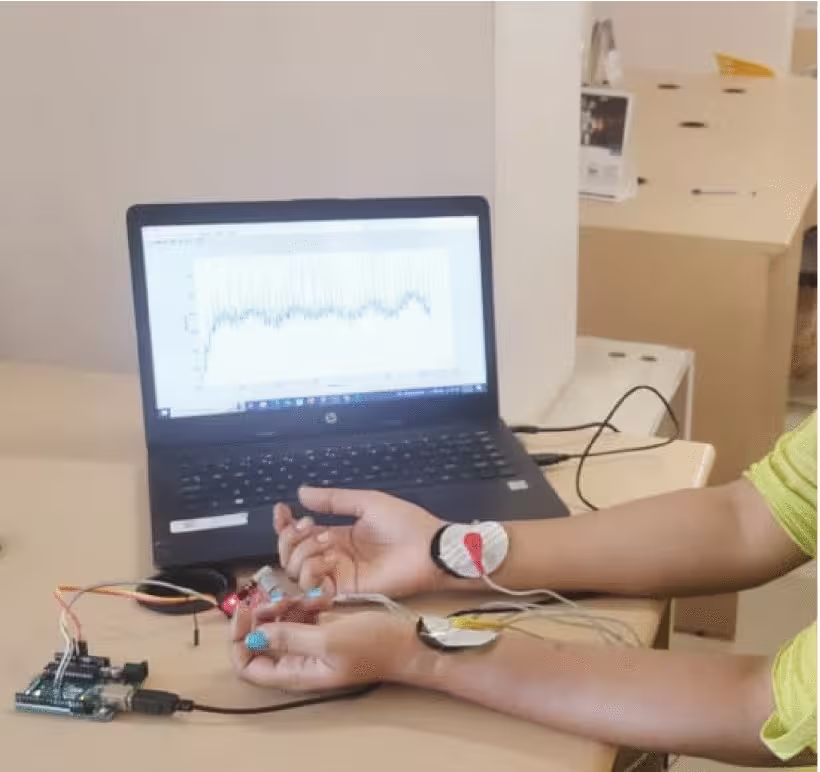Flexible Conductive Polymer Reinforced Polyurethane Foam for Real-Time Human Body Electrical Signal Sensing and ECG Peaks
Electrocardiogram (ECG) monitoring has advanced from traditional wet electrodes to more flexible, textile-based, knit-integrated sensors made from materials like cotton, silver yarn, spandex, and circuit boards. Traditional silver/silver chloride (Ag/AgCl) gel electrodes have significant limitations, such as drying out, reduced durability, and mechanical wear. These challenges highlight the need for more reliable, long-lasting alternatives for ECG, EEG, EOG, and PPG monitoring.
Innovations like tripolar concentric ring electrodes and flexible graphene gels improve signal quality and reduce impedance. Techniques like dip coating and free radical polymerization have also resulted in composites with a wide conductivity range, offering promising alternatives for long-term biosensing applications. Materials like carbon nanotubes, polypyrrole, silicone polymers, and polyaniline further enhance flexibility and conductivity, making them ideal for wearable biosensors. Zinc oxide nanoparticles improve sensor sensitivity, especially for detecting subtle motions.
This study introduces a novel polymer composite synthesized via in situ polymerization of polyaniline (PANI) with multi-walled carbon nanotubes (MW-CNTs) and zinc oxide (ZnO) integrated into a polyurethane (PU) foam substrate. The composite offers a sustainable alternative to conventional Ag/AgCl electrodes, combining PU foam's flexibility with the electrical conductivity and mechanical strength provided by PANI, multi-walled carbon nanotubes, and ZnO nanoparticles.
Five composite samples with varying PANI ratios were analyzed to optimize the material's properties. Scanning electron microscopy revealed smooth PANI, fibrous MWCNTs, and glowing ZnO clusters on a heterogeneous surface. Its excellent conductivity of 1817 sm-1 offers enhanced signal acquisition, making it ideal for long-term monitoring applications.
Uniform filler distribution in the sensor enhanced conductivity, mechanical strength, and antibacterial properties, while the porous PU foam structure ensured consistent performance across the surface. Fourier-transform infrared (FTIR) analysis also showed stable chemical bonding, validating the composite's structural integrity for biosensing applications.
ECG signals were acquired using the AD8232 sensor paired with an Arduino microcontroller for signal processing. The composite sensor detected mechanical strain from wrist movements during heartbeats and converted it into electrical signals.
In contrast to traditional gel electrodes, the material demonstrated stable electrical signal acquisition without drying out or degrading. The flexible foam base offers comfortable wearability, minimizing issues like skin irritation and dehydration, making it ideal for continuous, long-term monitoring.
MWCNTs enabled resistance changes in response to mechanical strain, PANI modulated the signal response for consistent output, and ZnO nanoparticles enhanced sensitivity. Together, they ensured a stable, precise, and responsive ECG signal. For accurate cardiac rhythm analysis, wavelet analysis and template matching were applied to detect R-peaks, confirming the sensor's reliability in real-time ECG monitoring.
The proposed conductive polymer composite of PANI, MWCNTs, and ZnO over a PU substrate is a genuinely flexible, dry, lightweight sensor with high conductivity (1817 sm-1) and stability. It offers a sustainable, comfortable, and durable solution for real-time human body ECG monitoring. Its superior performance and eco-friendly properties make it a promising alternative for noninvasive biomedical applications, improving patients' comfort and assisting in accurate diagnosis. Future work can explore wearable diagnostics and broader biosensing applications.




